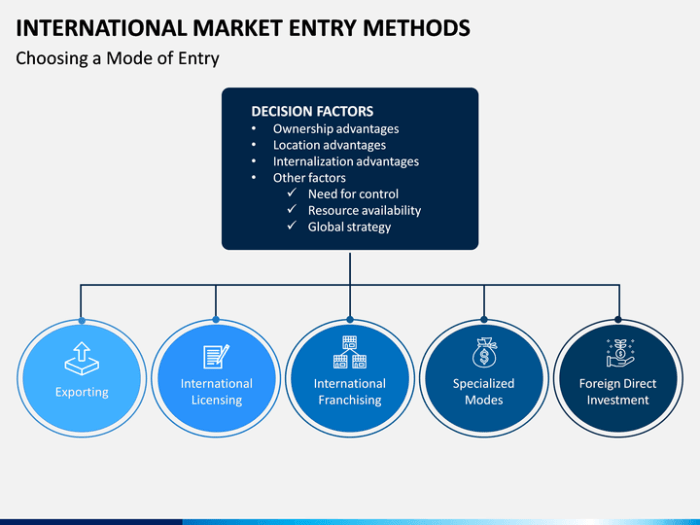Market Entry Strategies sets the stage for businesses to conquer new territories, navigate through uncharted waters, and emerge victorious in the global marketplace. Get ready to dive into a world of strategic decisions and calculated risks as we explore the dynamic landscape of market entry strategies.
From understanding different modes of entry to analyzing key factors and embracing adaptation strategies, this exploration will equip you with the knowledge and insights needed to make a mark in the competitive business arena.
Market Entry Strategies Overview

When a company decides to enter a new market, they need to carefully consider their market entry strategy. This involves planning and implementing various methods to establish a presence and gain a competitive advantage in the new market.
Types of Market Entry Strategies
- Exporting: Selling products or services to another country without setting up a physical presence there.
- Licensing: Allowing a foreign company to use your intellectual property in exchange for royalties.
- Franchising: Granting the rights to use your business model and brand to a foreign entity.
- Joint Venture: Partnering with a local company to establish a new business entity in the foreign market.
- Direct Investment: Setting up a wholly-owned subsidiary or acquiring an existing business in the foreign market.
Importance of Choosing the Right Market Entry Strategy
Choosing the right market entry strategy is crucial for the success of a company in a new market. The strategy selected should align with the company’s goals, resources, and capabilities. It can impact the level of control, risk, and investment required, as well as the speed of market entry and potential for growth. By selecting the most suitable market entry strategy, a company can maximize its chances of success and effectively navigate the complexities of entering a new market.
Modes of Market Entry
When entering a new market, companies have several options to choose from in terms of modes of entry. Each mode comes with its own set of advantages and disadvantages, making it crucial for businesses to carefully consider their options before making a decision.
Exporting
- Exporting involves selling products or services to a foreign market without establishing a physical presence in that market.
- Advantages:
- Low initial investment and risk.
- Quick entry into the market.
- Disadvantages:
- Limited control over distribution and marketing.
- Dependence on intermediaries.
Licensing
- Licensing allows a company in one country to grant another company in a foreign market the right to use its intellectual property, such as patents or trademarks, in exchange for royalties.
- Advantages:
- Low investment and risk for the licensor.
- Access to local market knowledge of the licensee.
- Disadvantages:
- Potential loss of control over brand image and quality.
- Risk of intellectual property theft.
Joint Ventures
- Joint ventures involve two or more companies from different countries coming together to form a new entity and share resources, risks, and profits.
- Advantages:
- Access to local partner’s knowledge and network.
- Shared risks and costs.
- Disadvantages:
- Potential conflicts between partners.
- Shared decision-making can slow down the process.
Direct Investment
- Direct investment involves setting up a wholly-owned subsidiary or acquiring an existing company in the foreign market.
- Advantages:
- Full control over operations and decision-making.
- Capture higher profits in the long run.
- Disadvantages:
- High initial investment and risk.
- Complexity of managing operations in a foreign market.
Factors to Consider
When choosing a market entry strategy, there are several key factors to consider. These factors can greatly influence the success of your entry into a new market and should not be overlooked.
Market Characteristics Influence
Market characteristics play a crucial role in determining the most suitable entry strategy. Factors such as market size, growth potential, competition level, and regulatory environment can all impact the choice of entry strategy. For example, entering a highly competitive market may require a different approach compared to entering a niche market with high growth potential.
- Market size: Consider the size of the market and whether it can support your business goals.
- Growth potential: Evaluate the growth prospects of the market and how it aligns with your long-term objectives.
- Competition level: Analyze the competitive landscape to determine how you can differentiate your offerings.
- Regulatory environment: Understand the regulations and policies that may affect your entry into the market.
Role of Cultural Differences
Cultural differences also play a significant role in determining the appropriate market entry approach. Understanding the cultural nuances of the target market is essential to building strong relationships with customers and stakeholders. It can impact communication strategies, product localization, and overall market positioning.
It’s crucial to adapt your entry strategy to align with the cultural preferences and norms of the target market.
- Communication strategies: Tailor your messaging to resonate with the cultural values and preferences of the target market.
- Product localization: Customize your products or services to meet the specific needs and preferences of the local consumers.
- Market positioning: Ensure that your brand positioning aligns with the cultural perceptions and expectations of the target market.
Market Research and Analysis

Market research plays a crucial role in developing effective market entry strategies by providing valuable insights into the target market, customer preferences, competition, and potential risks. Conducting thorough market analysis is essential to make informed decisions and minimize the chances of failure in entering a new market.
Importance of Market Research
Market research helps businesses understand the needs and preferences of their target audience, identify market trends, assess the competition, and evaluate the feasibility of entering a new market. By gathering and analyzing relevant data, companies can tailor their strategies to meet the specific demands of the market and increase their chances of success.
- Identifying target market segments
- Evaluating market size and growth potential
- Assessing competition and market trends
- Understanding consumer behavior and preferences
- Identifying potential risks and challenges
Steps for Conducting Market Analysis
Market analysis involves several steps to gather and analyze data effectively. These steps include:
- Define the objectives of the analysis
- Collect relevant data through primary and secondary research
- Analyze the data to identify key market trends and insights
- Evaluate the competition and assess market opportunities
- Develop strategies based on the findings to support market entry decisions
Impact of Market Research on Market Entry Strategies
Market research can significantly impact the success of market entry strategies by providing valuable information that guides decision-making and strategy development. For example, conducting thorough research can help companies identify untapped market opportunities, understand customer preferences, and tailor their products or services to meet the specific needs of the target market. Additionally, market research can help businesses anticipate potential challenges and risks, allowing them to develop contingency plans and adapt their strategies accordingly.
Adaptation Strategies
Adaptation strategies in market entry refer to the adjustments and modifications made by companies to their products, services, or marketing strategies to suit the specific demands and preferences of new markets. This process involves tailoring offerings to better fit the cultural, economic, and regulatory environment of the target market.
Product Adaptation, Market Entry Strategies
Product adaptation is a common strategy used by companies entering new markets. For example, fast-food chains like McDonald’s offer menu items that cater to local tastes and preferences in different countries. In India, McDonald’s introduced the McAloo Tikki burger to appeal to vegetarian customers, showcasing a successful adaptation strategy.
Marketing Strategy Adaptation
Companies often adjust their marketing strategies to resonate with the target market’s cultural norms and values. Nike, for instance, uses different advertising campaigns in various countries to connect with local consumers effectively. By adapting their marketing messages, companies can enhance brand awareness and customer engagement.
Service Adaptation
Service adaptation involves customizing the delivery of services to meet the unique needs of consumers in different markets. Airbnb offers localized customer support and payment options to accommodate diverse preferences worldwide. This tailored approach enhances customer satisfaction and loyalty.
Challenges and Benefits
Adapting strategies for different markets presents challenges such as maintaining brand consistency while catering to local preferences, navigating regulatory differences, and managing operational complexities. However, the benefits include increased market share, enhanced brand reputation, and improved customer satisfaction, ultimately leading to long-term success in new markets.





